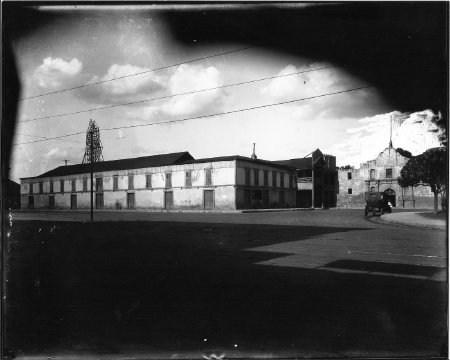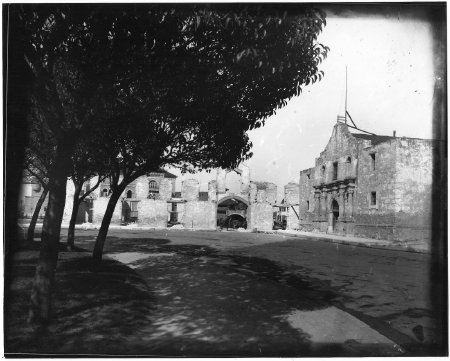History:
Beginning in 1879, a group of concerned citizens - several of them determined and influential women - began to focus their attention on the neglected Alamo buildings. Among the ladies advocating the cause of preservation, Mary Adams Maverick, Adina de Zavala and Clara Driscoll were the most instrumental.
In 1879, the newly formed Alamo Monument Association elected Mary Adams Maverick (1818-1898), the widow of pioneer Samuel Augustus Maverick, as their president. This group successfully convinced the Texas legislature to purchase the Alamo church from the Catholic Church in 1883 (Fisher 1996, 42-43).
Schoolteacher Adina de Zavala (1861-1955) was the granddaughter of a former Mexican diplomat, who joined the cause of Texas independence in 1835 and later rose to first vice president of the Republic of Texas. Clara Driscoll (1881-1945), the daughter of a wealthy rancher, could boast of two grandfathers who fought in the Texas Revolution. In 1892, Adina de Zavala obtained a verbal agreement from the owners of the Hugo-Schmeltzer Company that her preservation group would have the first option to buy the convento (Shiffrin, 224). She and her supporters joined the Daughters of the Republic of Texas (DRT), forming the De Zavala Chapter, the following year (Nelson, 83). Initially, de Zavala and Driscoll, who became a DRT member in 1903, found themselves united in a common cause: to preserve historic sites, especially the Alamo, "for the benefit of future generations" (Driscoll, Clara).
When the convento came up for sale, de Zavala lacked the necessary funds and turned to the wealthy Clara Driscoll to save the building from an eastern syndicate interested in building a hotel on the property (Shiffrin, 231). Driscoll purchased the convento with her own money in 1904. The State of Texas reimbursed Driscoll and awarded custody of both the Alamo church and convento to the DRT in 1905 (Nelson, 83).
What came to be known as the "second battle of the Alamo" took place between 1905 and 1912 when the two ladies disagreed over the fate of the convento, splitting the DRT into two rival factions. De Zavala's group wanted to restore the building for its significance as the major site of resistance during the 1836 battle, while Driscoll's supporters, who disputed the building's history, wanted it torn down to better showcase the Alamo church (Fisher, 56-57).
In 1879, the newly formed Alamo Monument Association elected Mary Adams Maverick (1818-1898), the widow of pioneer Samuel Augustus Maverick, as their president. This group successfully convinced the Texas legislature to purchase the Alamo church from the Catholic Church in 1883 (Fisher 1996, 42-43).
Schoolteacher Adina de Zavala (1861-1955) was the granddaughter of a former Mexican diplomat, who joined the cause of Texas independence in 1835 and later rose to first vice president of the Republic of Texas. Clara Driscoll (1881-1945), the daughter of a wealthy rancher, could boast of two grandfathers who fought in the Texas Revolution. In 1892, Adina de Zavala obtained a verbal agreement from the owners of the Hugo-Schmeltzer Company that her preservation group would have the first option to buy the convento (Shiffrin, 224). She and her supporters joined the Daughters of the Republic of Texas (DRT), forming the De Zavala Chapter, the following year (Nelson, 83). Initially, de Zavala and Driscoll, who became a DRT member in 1903, found themselves united in a common cause: to preserve historic sites, especially the Alamo, "for the benefit of future generations" (Driscoll, Clara).
When the convento came up for sale, de Zavala lacked the necessary funds and turned to the wealthy Clara Driscoll to save the building from an eastern syndicate interested in building a hotel on the property (Shiffrin, 231). Driscoll purchased the convento with her own money in 1904. The State of Texas reimbursed Driscoll and awarded custody of both the Alamo church and convento to the DRT in 1905 (Nelson, 83).
What came to be known as the "second battle of the Alamo" took place between 1905 and 1912 when the two ladies disagreed over the fate of the convento, splitting the DRT into two rival factions. De Zavala's group wanted to restore the building for its significance as the major site of resistance during the 1836 battle, while Driscoll's supporters, who disputed the building's history, wanted it torn down to better showcase the Alamo church (Fisher, 56-57).
About this Image:
1.) Looking northeast towards the front (west) facade of the Alamo and the west and south facades of the Hugo-Schmeltzer Building (left). The wooden façade around the convento has been almost completely removed as the first step towards restoration.
2.) Looking north at the remains of the old convento. The post office can be seen through the gaps in the walls, which were demolished at the request of the Clara Driscoll led chapter of the DRT to give greater prominence to the Alamo church at right.
2.) Looking north at the remains of the old convento. The post office can be seen through the gaps in the walls, which were demolished at the request of the Clara Driscoll led chapter of the DRT to give greater prominence to the Alamo church at right.
To Learn More:
Credit:
Courtesy of the San Antonio Conservation Society Foundation, Raba Collection.


